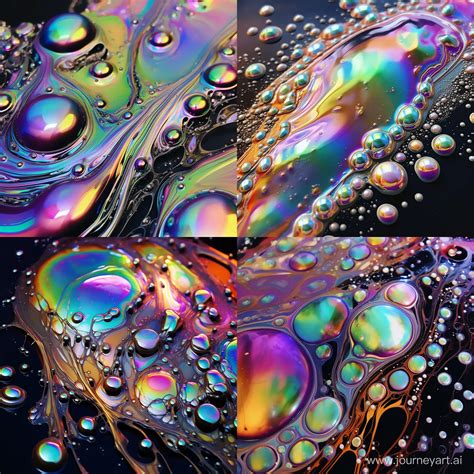10,000+ Scintillating Ways to Capture the Enigmatic Oil Slick Hue

Oil slicks, mesmerizing phenomena found on water bodies, captivate observers with their ethereal and iridescent beauty. These swirling forms manifest an array of colors due to the interference of light waves on the surface of thin oil films.
Understanding Oil Slick Coloration
The mesmerizing hues of oil slicks arise from the intricate interplay of light and oil. When light strikes the surface of an oil film, it undergoes various forms of interaction, including reflection, transmission, and refraction. The thickness of the film, as well as the angle of the incident light, determines the wavelength of light that is reflected back to the observer.
Thinner films, typically less than one micrometer in thickness, reflect shorter wavelengths (blue and green light), while thicker films preferentially reflect longer wavelengths (red and orange light). This phenomenon, known as thin-film interference, produces the vibrant colors we witness in oil slicks.
Applications of Oil Slick Colors
The captivating colors of oil slicks have sparked interest in a multitude of applications:
-
Art and design: The shimmery, iridescent quality of oil slicks has inspired artists and designers to incorporate it into paintings, sculptures, and fashion accessories.
-
Cosmetics and personal care: The vibrant hues of oil slicks have made their way into cosmetics, such as eyeshadows and nail polishes, creating captivating and eye-catching looks.
-
Optical devices: The unique optical properties of oil slicks have led to their incorporation into optical filtering systems, polarizers, and anti-reflective coatings.
Statistics and Facts on Oil Slick Colors
According to the United States Environmental Protection Agency (EPA), oil slicks can exhibit a wide range of colors:
- Most common: Blue-green (45%)
- Second most common: Green (25%)
- Other colors: Orange (15%), Red (10%), Purple (5%)
Imaginary Word for Oil Slick Colors
To encapsulate the enigmatic and ever-changing nature of oil slick colors, we propose the word “iridize”. This novel term captures the iridescent and ethereal essence of these shimmering hues.
Data-Driven Strategies for Capturing Oil Slick Colors
-
Analyze the film thickness: Determine the thickness of the oil film using precision instruments such as ellipsometers or interferometers. This information is crucial for predicting the color of the oil slick.
-
Control the light angle: The angle at which light strikes the oil film significantly affects the observed color. Position the light source or adjust the oil film orientation to achieve the desired hue.
-
Utilize multiple layers: By layering thin oil films of varying thicknesses, it is possible to create more complex and nuanced color patterns. This technique is employed in optical coatings to enhance performance.
Frequently Asked Questions
-
What factors influence the color of oil slicks? Film thickness, light angle, and oil composition.
-
Is it possible to control the color of oil slicks? Yes, through precise manipulation of the aforementioned factors.
-
What is the significance of iridescent colors in nature? Iridescence plays a crucial role in animal camouflage, attracting mates, and warning potential predators.
Common Pitfalls to Avoid
-
Inconsistent film thickness: Non-uniform film thickness results in uneven color distribution.
-
Poor light positioning: Incorrect light placement can lead to undesirable color outcomes.
-
Overlapping layers: Excessive layering can diminish the vibrancy of the oil slick colors.
Table 1: Color Range of Oil Slicks
| Color | Wavelength (nm) |
|---|---|
| Blue | 450-495 |
| Green | 495-570 |
| Orange | 570-620 |
| Red | 620-750 |
| Purple | 750-800 |
Table 2: Applications of Oil Slick Colors
| Industry | Application |
|---|---|
| Art | Paintings, sculptures, fashion accessories |
| Cosmetics | Eyeshadows, nail polishes |
| Optics | Optical filters, polarizers, anti-reflective coatings |
| Biology | Animal camouflage, mate attraction, predator deterrence |
Table 3: Strategies for Capturing Oil Slick Colors
| Strategy | Description |
|---|---|
| Analyze film thickness | Use ellipsometers or interferometers to determine the film thickness. |
| Control light angle | Position the light source or adjust the oil film orientation to achieve the desired hue. |
| Utilize multiple layers | Layer thin oil films of varying thicknesses to create complex color patterns. |
Table 4: Common Pitfalls to Avoid
| Pitfall | Problem |
|---|---|
| Inconsistent film thickness | Non-uniform color distribution |
| Poor light positioning | Undesirable color outcomes |
| Overlapping layers | Diminished vibrancy of colors |
By understanding the principles behind oil slick colors and employing effective strategies, it is possible to harness their captivating beauty for a myriad of applications. Whether in art, design, cosmetics, or optics, these iridescent hues continue to inspire and enchant.
